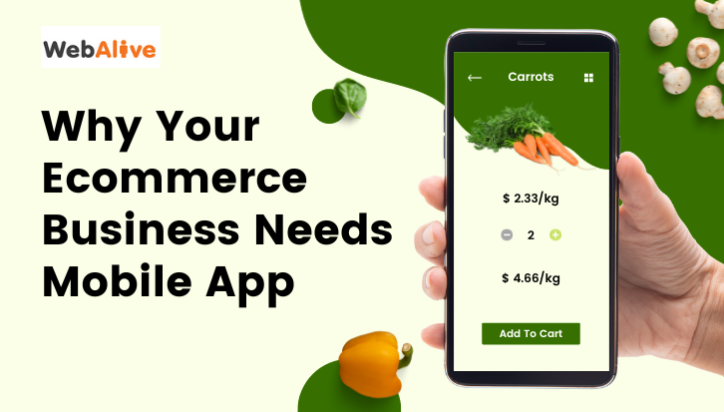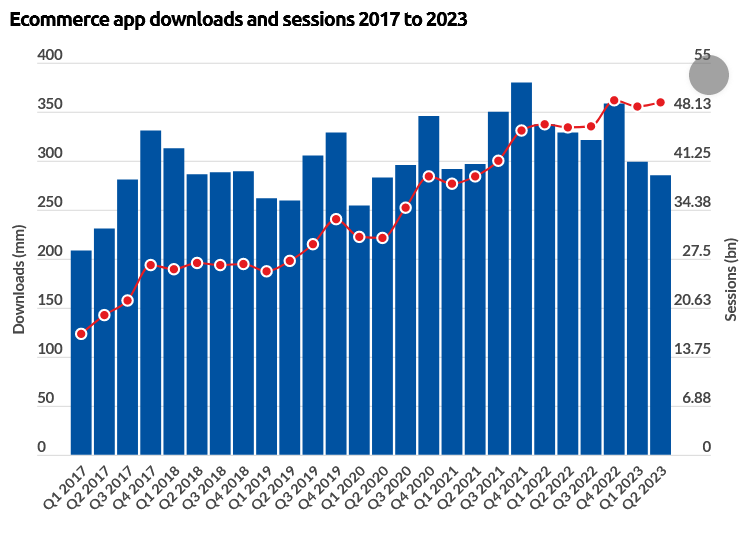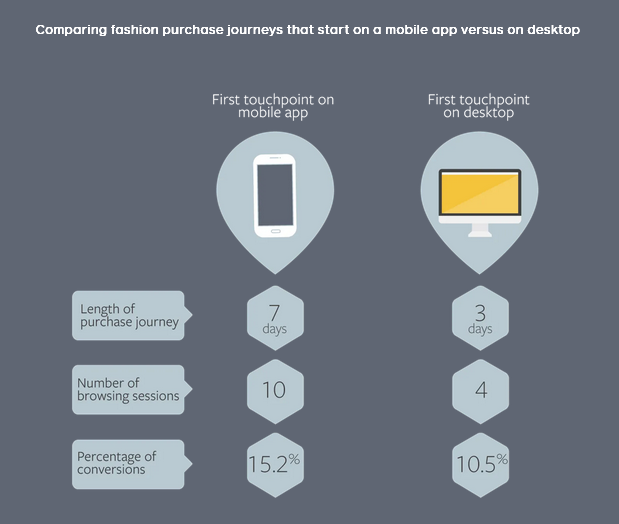
7 Reasons Why Your Ecommerce Business Needs Mobile App
With tens of thousands of shopping apps being added to Apple and Google’s app stores each year, it is no secret that when it comes to ecommerce, an excellent mobile app is more important than ever. Even asking if it’s necessary to make a mobile app seems out of line.
We can take ecommerce giants like Amazon or eBay as examples of those who launched their mobile apps and see how far-reaching and successful their endeavours have become. No wonder, in recent times, engaging with customers through ecommerce mobile apps has become a fundamental practice for savvy business owners.
In this article, we will give a gist of the key advantages of using mobile apps for ecommerce.
Why your ecommerce business needs a mobile ecommerce application?
Irrespective of the size of your business, continue reading to understand how mobile apps can effectively contribute to scaling your ecommerce business.
1. Shoppers prefer mobile apps to shop
Shopping online is now easier than ever, with the surge in mobile traffic and the widespread use of mobile payment apps. Although there is no precise figure for the total number of mobile shoppers, studies indicate that a minimum of 79% of smartphone users have made purchases using their devices.
Due to easy access, ease of payment and better user experience, a large segment of customers prefers mobile apps. All they need to do is tap on an icon on their mobile screen to search for products and services. However, neglecting a mobile app for your online store means missing out on a big part of the market and not giving your current customers the best experience possible.
According to research, from 2017 to 2023, more people used ecommerce apps, with sessions going up by 121%, alongside downloads going up by 27%.

2. Increases sales and revenue growth
A well-designed ecommerce app brings up stronger customer engagement and loyalty, leading to increased sales and revenue. Customers can browse and shop at any time with a simple tap on their mobile device. Many ecommerce apps leverage mobile device features such as cameras, GPS, and sensors to offer unique and innovative features.
For example, if you use augmented reality (AR) for product visualisation or location-based promotions, it will boost the overall shopping experience and encourage users to make purchases. And the rise in orders implies your profits increase.
We can take Nike as an example. Established in 1971, the company saw its revenue grow from $25.3 billion in 2013 to $46.71 billion in a decade. Here, the mobile app, with over 5 million downloads, played a key role in this success, offering features like a visual search for instant shoe discovery.
3. Boost marketing communications
An ecommerce business app creates a more direct and engaging channel between the business and its customers. You can push notifications for promotions, discounts, new product announcements, and other marketing campaigns, keeping customers engaged and prompting them. Even you can customise the push notifications for users by considering their preferences, behaviour, and location for more relevant and engaging communication.
There is an option open for targeted messaging where you can communicate directly within the app, providing targeted information to users while they are actively engaged. Integrating social sharing features within the app allows users to share their favourite products, reviews, or purchases on social media platforms.
This user-generated content serves as a form of word-of-mouth marketing and extends the reach of your brand through social channels.
4. It delivers a personalised shopping experience
The mobile app can analyse a customer’s past purchases, browsing history, and behaviour to offer personalised product recommendations to showcase items that align with the customer’s preferences. This targeted approach boosts the chances of customers discovering value in the app, resulting in increased satisfaction and a feeling of being truly understood by the brand.
Even the mobile app retains user preferences, including preferred payment methods, shipping addresses, and communication choices. This not only saves customers time during checkout but also ensures a smoother and more efficient shopping experience.
5. Drives higher conversion rates
A higher conversion rate is another primary reason why your ecommerce store should have a mobile app. A mobile app enables you to effortlessly gather real-time information about your users, be it about interests, demographics or location. Then, you can leverage this data to customise their experience for optimal personalisation.
If you’re depending solely on a mobile website for conversions, you’re overlooking a significant opportunity. The key to optimising conversions lies in having a mobile app. While mobile apps and websites may appear similar at first, the conversion rates tell a different story. How can one platform outperform the other, especially when accessed on the same device?
In this guide, I’ll delve into why mobile apps boast better conversion rates than mobile sites. By the end, you’ll grasp the significance of developing an app for your website or business.

6. Lowest shopping cart abandonment rate
Shopping cart abandonment is one of the major problems for ecommerce businesses. Apps frequently provide a more straightforward and efficient checkout process compared to mobile websites by reducing the number of steps and fields customers need to navigate. Also, by saving the payment details, apps eliminate the need for customers to re-enter their payment information for each transaction, reducing friction and saving time during checkout.
The timely notifications, such as push notifications, serve as prompts for users to complete their purchases by reminding them about items left in their carts. The quicker loading and responsive design enhance the user experience, minimising frustration and the chance of abandonment.
7. Build a strong customer base
Ecommerce apps can significantly improve customer experience in various ways, contributing to increased satisfaction, loyalty, and overall success. Streamlined checkout processes are common in ecommerce apps. Features, like saved payment info, one-click ordering, and user-friendly navigation, contribute to a quicker, more efficient transaction, minimising frustration and improving the overall experience.
Even ecommerce apps can leverage device features such as cameras, GPS, and sensors. This opens up opportunities for innovative features like augmented reality for product visualisation, barcode scanning, or location-based services, enhancing the overall user experience. Also, apps can provide a platform for customers to leave reviews and feedback that helps other shoppers make informed decisions.
Let’s have a look at some Interesting Statistics:
- As reported by Statista’s Market Insights, in 2023, mobile ecommerce sales soared to an impressive $2.2 trillion, constituting a substantial 60 per cent of the total global ecommerce sales.
- M-commerce apps lead mobile shopping, capturing 54% of total mobile commerce payments.
- Shopping app usage has consistently increased, with a steady annual growth rate of 18% over the years.
- 60% of consumers prefer mobile shopping apps for a better user experience, with 88% having at least one app on their phone.
Final words
With all these being said, it comes with no doubt that mobile apps go beyond being mere transaction platforms; they are dynamic tools that align with the expectations of modern consumers. Not only does it meet their demands for convenience and personalisation, but it also positions your brand as forward-thinking and customer-centric. So, embracing a mobile app is crucial for competitiveness, brand loyalty, and sustained ecommerce growth.
You read a lot. We like that
Want to take your online business to the next level? Get the tips and insights that matter.

